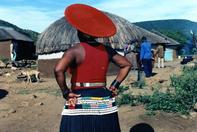Daily Routine
In the past, daily life in an Zulu homestead 'umuzi' followed roughly the same routine. A clear distinction was made on the basis of sex, age and rank. The young boys were responsible for taking the cattle out into the veld to graze; the girls, either on their own or with their mothers, went to the river to fetch water.

Thus Zulu children were exposed to nature at an early age, inculcating a deep, lasting understanding and empathy for the environment in which they lived. After breakfast, usually served mid-morning, the women busied themselves sweeping, cleaning pots and doing other domestic chores. In summer, early in the day while it was still cool, they would go to the fields to weed their crops. In the late morning the herdboys would return with the cattle, which were milked in the cattle byre. After milking, the first meal of the day was eaten. Cooking was done on a hearth within the dwelling in a large cooking pot 'ikhanzi'.
Then, as now, amasi 'curds of milk' formed an important part of the diet: it was eaten either on its own or mixed with maize meal or vegetables. To this day, another staple, maize meal, is produced in some homesteads by laboriously grinding corn between two rocks.
Men were less involved in domestic chores and spent much of their time attending meetings in the iband/a 'chief's court', a recognized meeting place usually under trees outside the umuzi, or doing private work, such as repairing their shields or working skins. Women were, and still are, responsible for mat-making and beadwork, which they learn from their mothers.
Pottery is a highly skilled craft practised by comparatively few. All woodwork is done by men, who usually specialize in making particular items, like spoons, meat trays and milk pails, which are carved from solid pieces of wood. Hardly any carvers still make headrests because people now prefer to use pillows.
Blacksmithing was a specialized profession, traditionally practised in secret and often restricted to the male members of one family only. The main items made were hoes, for cultivating the fields, and the blades of spears, the principal weapons of war. From about the 1830s, the major source of metal was through trade with the English and Portuguese.
Beads, cloth, brass and muskets were exchanged for ivory, labour, skins and cattle. This trade resulted in the rapid demise of traditional iron-smelting skills, as more easily smithed, but inferior, raw iron became increasingly accessible from passing traders.